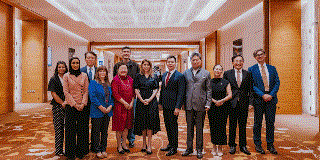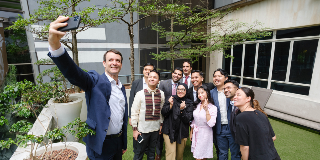As philanthropy in Asia continues to evolve, wealth holders are increasingly seeking ways to align their financial capital with their values, driving sustainable, long-term impact. Amid one of the largest intergenerational wealth transfers in history, there is a growing momentum to move beyond traditional grantmaking, with many embracing a more integrated approach that views philanthropy as an asset class in its own right.

Dawn Tan, Head, Asia Centre for Changemakers
At the Wealth Management Institute's Asia Centre for Changemakers (ACC), this shift is central to their mission to empower the next generation of philanthropists. In this feature, Dawn Tan, Head of ACC, explores how Holistic Philanthropy—an approach that blends investments, giving, and business practices—can help wealth holders transform their capital into a force for good.
PAA: Holistic Philanthropy encourages a redefinition of the relationship between profit and philanthropy, moving beyond traditional grantmaking to viewing philanthropy as an asset class and even embedding impact into business. How can philanthropists practically apply this approach within the fast-evolving wealth ecosystem in Asia?
Dawn: We believe that at the heart of philanthropy is the question of how and why we unlock capital at its highest and best use for positive lasting impact.
As philanthropy in Asia is accelerating and intersecting the largest intergenerational wealth transfers of our time, we are witnessing a confluence of factors such as the rise of socially conscious wealth holders who want to do more, quickly, and businesses transformations in response to growing calls for impact and equity. The question on everybody’s mind is: how do we get there?
Our answer to that is Holistic Philanthropy, where we seek to reconcile dichotomies by blending, innovating, aligning and accelerating a total approach towards harmonising profits, passion and impact. This means:
• Clarifying our relationship with capital not in isolated functions (invest, give, retain etc.), but as how capital can be deployed and aligned across the impact spectrum for a range of needs and situations
• Transforming one’s wealth into a total portfolio approach with a clearer sense of the interrelatedness of their investments, giving and legacy to impact
• Being comfortable with breaking down dichotomies or mental barriers and evoking paradigm shifts away from conventional styles of giving when it comes innovating or scaling their capital for impact
Ultimately, we hope to guide wealth holders in holistically transforming not just themselves, but also their businesses, so as to drive a purposeful and aligned relationship between positive impact and capital.
We are excited to share how Holistic Philanthropy can be practiced in detail in our upcoming report titled Unlocking Holistic Philanthropy for Impact to be published in Q1 2025.
PAA: The report stresses the importance of systems and design thinking to align philanthropic strategies with community needs. Could you share an example of how this approach could transform a philanthropist’s impact?
Dawn: Systems Thinking and Design Thinking are established logic frames that have been applied in many organisational contexts, including successful philanthropic approaches. We think that they are apt at responding to the complexities of contemporary social and environmental issues, or “wicked problems”.
Systems Thinking, or the approach of deciphering complex systems through interconnectedness and interdependencies, can be used to identify intended and unintended consequences of philanthropic initiatives. Design Thinking, on the other hand, allows for philanthropists to work closely with local communities to co-create and design solutions. Taken together, they engender solutions that are more thoughtful, accountable and empowering to local communities.
For example, systems and design thinking enable philanthropists to consider how to best combat malnutrition and poverty. Besides providing free meals—which on its own might create dependency problems in the long run—funders may instead consider examining the interrelated factors contributing to the issues in the area, and invest in co-designing resilient and sustainable initiatives with locals that focus on cultivating community-based assets. This helps funders be certain that local communities can thrive long after the programmes have concluded.
PAA: The ACC’s mission is to empower emerging changemakers and drive regional impact through education, community-building, and knowledge-sharing. What initiatives or programmes can we expect from the ACC in the coming year to advance these goals?
Dawn: Since ACC was launched in April 2024, we’ve marked some key milestones.
First, we celebrated Asia’s inaugural cohort of certified philanthropy advisors, with skills fully mapped to industry needs. The Class of 2024 were ACC’s first graduates from our Certified Impact Philanthropy Professional (CIPP) programme, which trains wealth advisors and professionals from family offices, foundations, nonprofits, and corporates to better guide their clients and family principals towards more strategic philanthropy. This is a key step towards professionalising the philanthropy talent pool to support impact endeavours, and ACC will continue to refine and expand CIPP in the coming years.
For wealth holders and high-impact social innovators, we launched our flagship Changemakers Impact Endeavour Fellowship (CHIEF) programme in September. CHIEF is the first programme of its kind in Asia, where wealth owners and social innovators will embark on an impact journey together. Throughout the course of one year, they will reimagine the purpose of capital, investigate the impact landscape, evaluate impact projects and discover how different funding models may suit different situations. Ultimately, through CHIEF, we hope to build a community who will work together to create revolutionary solutions for Asia’s challenges, using their strategic resources. CHIEF will start in 2025 and we are really excited about the potential – our faculty is top-notch! CHIEF is currently open for applicants, so we would love to invite suitable candidates to register their interest with us here.
Research is another key pillar we want to build out at ACC. We are keen to bring Asia-focused, actionable thought leadership to our community, and to do so in a way that is innovative and accessible. Besides our internal expertise, we will also be tapping the wealth of knowledge in the Temasek Trust ecosystem and collaborating with global institutions.
All these efforts ties in to our mandate to accelerate philanthropy in Asia by innovating, scaling and aligning what wealth holders can do in their giving journeys, unlocking the region’s potential as a philanthropic powerhouse for our world’s biggest challenges.
------------------
Established by the Wealth Management Institute, the Asia Centre for Changemakers (ACC) aims to build capacity and nurture a strong pipeline of active and informed changemakers with a focus on Asia. Our mission is to empower these individuals to deploy their resources, skills and passion for a better tomorrow.
As Asia’s foremost learning lab for philanthropy and impact capital, the ACC is committed to guiding family principals, professionals, advisors and social entrepreneurs in moving up the learning curve, through three key initiatives: Building capabilities, talent, and professionalism in the impact sector; fostering a community of practice; and shaping and sharing Asian-grown thought leadership. The ACC is supported by Temasek Trust and the Philanthropy Asia Alliance.
The ACC also houses the Impact Philanthropy Partnership (IPP), a joint initiative with the Private Banking Industry Group (PBIG) and WMI, with support from the Monetary Authority of Singapore (MAS). The Partnership is an open platform that brings together wealth owners to collectively tackle society’s most pressing challenges and issues, through innovative and impactful philanthropy.








.tmb-.png?Culture=en&sfvrsn=7fea9931_1)


.tmb-.gif?Culture=en&sfvrsn=e13997ec_1)





.tmb-.gif?Culture=en&sfvrsn=3f4b1163_1)






.tmb-.gif?Culture=en&sfvrsn=b5ece239_1)
.tmb-.gif?Culture=en&sfvrsn=6fb3b6df_1)



.tmb-.jpg?Culture=en&sfvrsn=fedc60fc_1)
